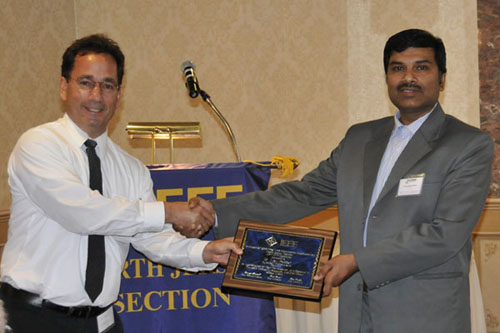The State-of-the-Art: Metamaterial Mobius Reconator Oscillator,Applications in Modern Communication Systems
 The growing interest in Metamaterial based RF and a microwave component is due to the manipulation ability over electromagnetic as well as sound waves. The core concept of metamaterial is to replace the molecules with man-made structures, viewed as “artificial atoms†on a scale much less than the relevant wavelength. The emerging trend is to develop an artificial media with negative refractive index for the application of high Q-factor resonator, invisible cloak, and superlens which allows resolution imaging far beyond the capability of the current technology. High-resolution acoustic imaging techniques are the essential tools for nondestructive testing and medical screening. However, the spatial resolution of the conventional acoustic imaging methods is restricted by the incident wavelength of ultrasound. This is due to the quickly fading evanescent fields which carry the sub-wavelength features of objects. By focusing the propagating wave and recovering the evanescent field, a flat lens with negative-index metamaterial can potentially overcome the diffraction limit. In this talk, detailed theory, prcatical limitation, and experimental results for metamaterial resonator based oscillators are presented for the benefiot of attendees.
The growing interest in Metamaterial based RF and a microwave component is due to the manipulation ability over electromagnetic as well as sound waves. The core concept of metamaterial is to replace the molecules with man-made structures, viewed as “artificial atoms†on a scale much less than the relevant wavelength. The emerging trend is to develop an artificial media with negative refractive index for the application of high Q-factor resonator, invisible cloak, and superlens which allows resolution imaging far beyond the capability of the current technology. High-resolution acoustic imaging techniques are the essential tools for nondestructive testing and medical screening. However, the spatial resolution of the conventional acoustic imaging methods is restricted by the incident wavelength of ultrasound. This is due to the quickly fading evanescent fields which carry the sub-wavelength features of objects. By focusing the propagating wave and recovering the evanescent field, a flat lens with negative-index metamaterial can potentially overcome the diffraction limit. In this talk, detailed theory, prcatical limitation, and experimental results for metamaterial resonator based oscillators are presented for the benefiot of attendees.
Date and Time
Location
Hosts
Registration
Speakers
 Dr. Ajay Poddar
Dr. Ajay Poddar
The State-of-the-Art: Metamaterial Mobius Reconator Oscillator,Applications in Modern Communication Systems
Biography: Dr. Ajay K. Poddar graduated from IIT Delhi, Ph.D. from TU-Berlin (Technical University Berlin) Germany. Dr. Poddar is a Chief Scientist, responsible for design and development of state-of-the-art technology RF front-end modules (oscillator, mixer, amplifier, filters, and MEMS based RF components) at Synergy Microwave Corporation NJ, USA. Previously, he worked as a Senior Scientist and Asst. Director in DRDO (Defense Research and Development Organization) (1991-2001), India. Dr. Poddar holds over two dozen patents (US, European, Japanese patents) and has published more than 200 scientific papers in international conferences and professional journals, contributed as a coauthor of 6 technical books. Dr. Poddar is a recipients of three time DRDO young scientist awards (1997, 1999, 2000), and IEEE USA Outstanding research scientist award (2009), and IEEE MTT-S Chapter chair award (2013). Dr. Poddar is a senior member of professional societies IEEE (USA), AMIE (India), and IE (India) and involved in several academic review committee and Academic Advisory, including PhD Advisors.
Email:
Address:Paterson, New Jersey, United States, 07504
Agenda
In 1967 Veselago did ground breaking work on electromagnetic materials with simultaneously negative values of “ε†and “μâ€. This typical property of material is described as artificial materials and nomenclatured in the literature by left–handed materials (LHM), negative index materials (NIM), backward–wave material, and double–negative materials (DNM). They are designed to interact with and control electromagnetic waves. Unusual properties of Metamaterials have allowed novel applications, concepts and devices.
In negative index materials, the electric, magnetic and Poynting vectors still form a right-handed triad; however E, H, and k form a left-handed triad. This is why materials with these properties are sometimes referred to as LHM. Their electromagnetic properties are significantly different from those of the right-handed materials because the group and phase velocities of electromagnetic waves in LHM (or NIM) oppose each other such that S and k are in opposite directions. For example, if an electromagnetic wave incident on an interface between a right-handed and a left-handed material, then the refracted wave stays on the same side of the interface normal and its refracted angle is negative, which is a reversal of Snell’s Law.
The analysis of Metamaterials can be performed on either the microscopic or macroscopic level. At the macroscopic level only the average bulk effects of the material are considered. On the microscopic level the interactions of electromagnetic waves with the structure are analyzed explicitly. The material properties of permittivity, permeability, and chirality are all macroscopic concepts derived from the microscopic electrical response of matter. For instance, permittivity at the microscopic level results from the electric dipole moment induced in an atom by an electric field. The response of matter to electric excitation is classified into different types of polarization. These include electric, magnetic, atomic, ionic, orientational, and interfacial polarization. All of these polarization mechanisms add together to give the macroscopic material properties.
In this presenation, propeties and chareteristics of artificial material (metamaterial) is discussed for the application in Ghz MICROWAVE MODULES for modern communication systems.


 Add Event to Calendar
Add Event to Calendar